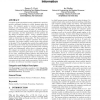170 search results - page 19 / 34 » Measuring Agent Intelligence via Hierarchies of Environments |
ATAL
2007
Springer
14 years 3 months ago
2007
Springer
This article deals with the problem of collaborative learning in a multi-agent system. Here each agent can update incrementally its beliefs B (the concept representation) so that ...
IDEAL
2005
Springer
14 years 2 months ago
2005
Springer
The neural representation of space in rats has inspired many navigation systems for robots. In particular, Self-Organizing (Feature) Maps (SOM) are often used to give a sense of lo...
ATAL
2008
Springer
13 years 11 months ago
2008
Springer
Computer agents participate in many collaborative and competitive multiagent domains in which humans make decisions. For computer agents to interact successfully with people in su...
PAMI
2010
13 years 3 months ago
2010
Abstract--This paper presents local spline regression for semisupervised classification. The core idea in our approach is to introduce splines developed in Sobolev space to map the...
AAAI
2010
13 years 10 months ago
2010
The concept of distance rationalizability allows one to define new voting rules or "rationalize" existing ones via a consensus class of elections and a distance. A conse...

